Most people think of the ocean as a place of beauty and mystery, home to a myriad of exotic creatures. But, there are also many dangerous sea creatures that can pose a threat to humans. These most dangerous sea creatures include sharks, stingrays, jellyfish, etc. While most encounters with these animals are harmless, they can sometimes be deadly. Thus it is important to be aware of the dangers that exist in the ocean and to take precautions when swimming or diving in areas where these creatures might be present.
Table of Contents
Stingray

Dangerous features: Stingray is said to be deadly and has killed many people in the past.
Stingrays are a type of fish that is commonly found in tropical and subtropical waters around the world. There are 220 approximated unique species of stingrays have been identified. Stingrays have gained increased attention in recent years, and are now frequently included on the IUCN Red List.
Although stingrays are not generally considered to be dangerous, they can be deadly if a swimmer is stung by one. Stingrays dig holes in the sand in shallow water and may sting if you step on them. The sting of a stingray can be deadly if it hits a major blood vessel or organ.
Lionfish
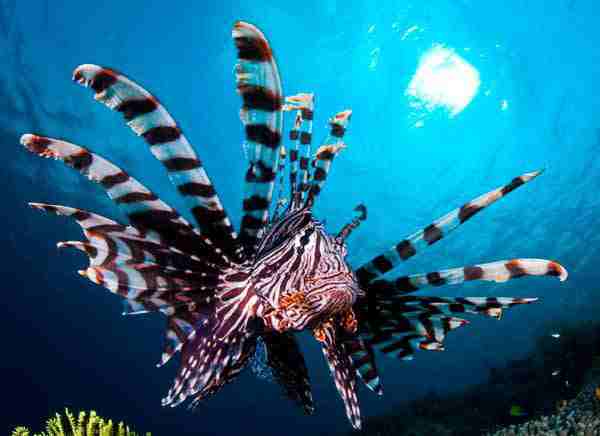
Dangerous features: Poison on their spines when stung can cause serious problems for humans.
Lionfish, also known as zebrafish and firefish, are fascinating marine fish that are highly poisonous. They have spiky fins that stretch out from their bodies and are brilliantly colored with red, white, and black stripes.
Lionfish fish are great predators, and they can cause problems for both swimmers and fishermen. Lionfish have venomous spines that can cause extreme pain, vomiting, nausea, and difficulty breathing in humans. Their venom can also lead to diarrhea, heartburn, headache, and numbness. Although lionfish venom is not highly dangerous, it can cause extreme allergic reactions in some people, which can result in hospitalization and death.
Barracuda

Dangerous features: extremely sharp teeth with toxins in their flesh.
The barracuda is a formidable predator in the sea due to its massive size, sharp teeth, and aggressive nature. These marine creatures are widespread in the world’s tropical and subtropical seas, and they tend to concentrate close to the coral reefs that dot the open ocean. With their keen fangs and muscular jaws, barracudas can take down smaller fish like lionfish at rates of up to 27 miles per hour.
However, attacks by barracudas on humans are extremely uncommon, they have been known to happen on rare occasions, usually when the barracuda mistook the snorkeler for prey.
Sea snakes
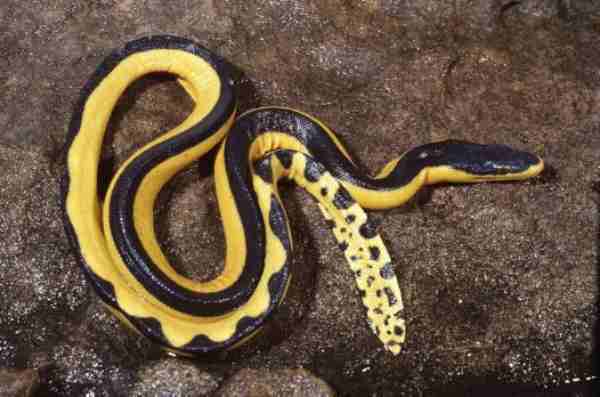
Dangerous features: Extremely poisonous venom. A human being can be killed by as little as a single drop.
Sea snakes are venomous that are not able to adapt to life on land instead spend their entire lives in the water. They have a compressed body and can be easily mistaken for an eel due to their location in warm coastal waters. These snakes need to come up for air at regular intervals. They also vary in terms of their personality, with some being quite gentle while others are more aggressive.
Only certain species of sea snakes should be handled by humans. The majority is classified as nonaggressive. One species, however, hydropathic platurus, contains venom that is more powerful than that of any terrestrial snake. There have been confirmed deaths, however, the numbers are quite low.
Cone snail

Dangerous features: Up to twenty people can be killed with only a single drop of their venom.
Cone snails are small, unassuming creatures, but they pack a powerful punch. These sea snails are extremely venomous, and their sting can be fatal to humans. There are over 600 species of cone snails in the world, and each has a unique shell with colorful and complex patterns. Despite their dangerous nature, humans often collect cone snails for their striking appearance.
The venom of a cone snail is very toxic, but it also has medical uses. Researchers have found that cone snail venom can be used to treat pain, and it is being studied as a potential treatment for other conditions like Alzheimer’s disease and cancer. While cone snails are deadly creatures, their venom could one day be used to save lives.
Stonefish
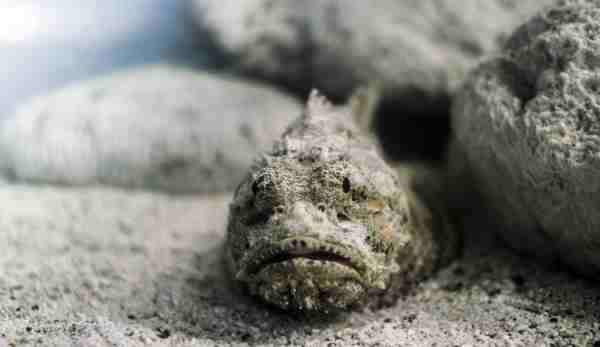
Dangerous features: Venom that stops your heart and is very painful.
The stonefish is a type of fish that Inhabitat the Indian and Pacific oceans. It is poisonous. Many people think these fish are the most dangerous living fish because their stings can be very painful and often send people to the hospital or kill them. Stonefish have long, sharp spines all over their bodies that they use to inject their poison into their prey.
The most common way that swimmers get stung by these fish is when they step on them and push the poison into their feet. But these fish can also sting when tourists or divers pick them up.
Titan Triggerfish
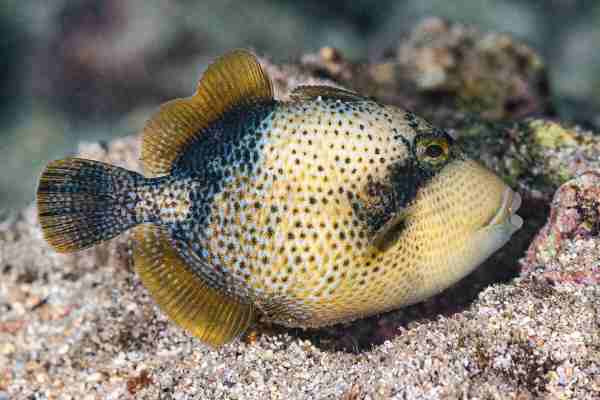
Dangerous features: Has the ability to pierce the skin with its teeth.
The triggerfish is a type of fish that lives in coral reefs in the seas from Australia to Thailand. Divers who get too close to these fish’s nests have been bitten by them when they act aggressively.
The triggerfish can get as long as 30 inches (75 cm) and eats coral, sea urchins, mollusks, and tube worms. People have also seen them act aggressively toward other fish. Their bites are painful and can cause serious injuries, like puncture wounds, but they are not poisonous.
Flower urchin
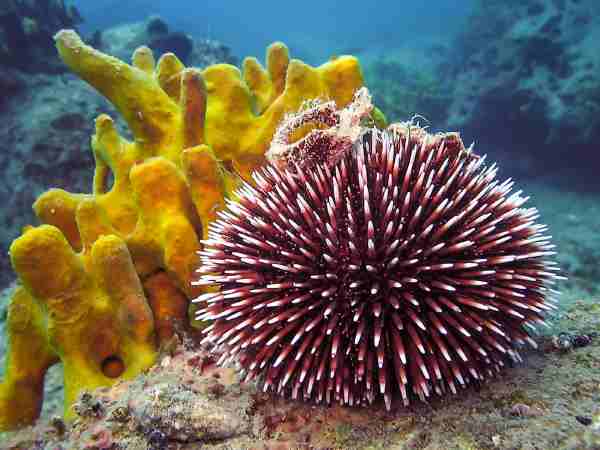
Dangerous features: Spines that are very sharp and poisonous.
Flower urchins are one of the most dangerous creatures in the ocean. They’re covered in poisonous spines that can cause excruciating pain if they come into contact with human skin. In some cases, the sting is so severe that it requires hospitalization. Flower urchins live in seagrass beds, sandy environments, and coral reefs.
They get their name from their flower-like patterning and pinkish colors. If you’re unlucky enough to be stung by a flower urchin, you may experience paralysis of the tongue, lips, eyes, and muscles. You may also feel faint, have difficulty breathing, and be unable to speak. Tsutomu Fujiwara, a scientist who accidentally stung himself with a flower urchin, described feeling like he was “going to die.”The discomfort, however, subsided within fifteen minutes.
Blue-Ringed Octopus
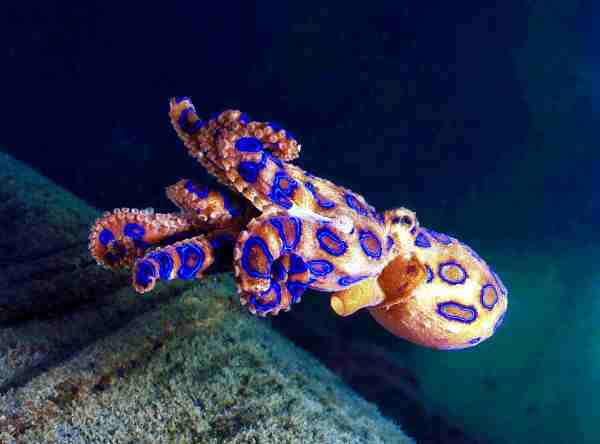
The blue-ringed octopus is a small species of octopus that lives in rock pools in the Pacific and Indian oceans. It is a beautiful and dangerous animal. They are easy to spot because their skin is yellow and their rings are blue and black. Most of the time, crabs, shrimp, and other small animals are what they eat.
Scientists have said that they are one of the most dangerous animals in the world. Its sting causes total paralysis, which can lead to drowning if the victim is in sufficient depths. This adverse effect is induced by tetrodotoxin, a toxic substance that can be lethal if it comes into contact with a human. There is currently no antivenom available.
Box Jellyfish
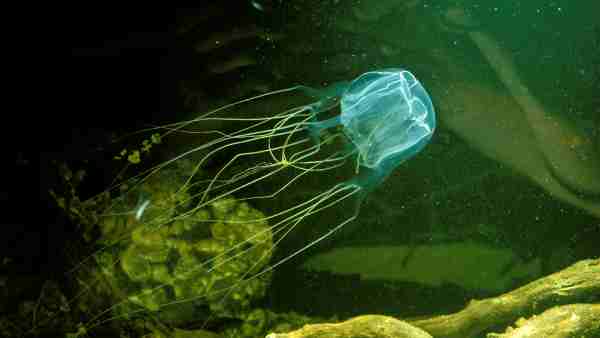
Dangerous features: has poison that can kill as many as 60 people.
Box Jellyfish are one the many dangerous creatures that inhabit the world’s oceans, box jellyfish are among the most feared. There are 51 different species of box jellyfish, and all of them are capable of delivering a painful, sometimes life-threatening sting.
What makes these jellyfish so dangerous is their speed and stealth; they can swim quickly and quietly through the water, making them difficult to spot until it’s too late. If a tentacle brushes up against the skin, thousands of venomous nematocysts will attach to the body and inject their poison. The pain from a box jellyfish sting has been described as excruciating, and in some cases, it can be rapidly fatal.
The Chironex fleckeri, for example, is one of the most venomous animals on earth; its sting can kill a human in as little as five minutes. Fortunately, there are steps that can be taken to avoid encountering these dangerous creatures.
For example, swimmers should exercise caution in areas where box jellyfish are known to live, and they should always wear protective clothing if they are at risk of being stung. By taking these simple precautions, you can help to ensure a safe and enjoyable experience when swimming in the ocean.
FAQs
What is the safest sea creature?
Jellyfish
What is the 1st deadliest animal?
The mosquito
Which sea animal has no death?
The jellyfish Turritopsis dohrnii.
What is the number 1 predator in the ocean?
Killer Whales
What kills the most sea life?
Although exact numbers are hard to come by, it is estimated that 100,000 marine mammals each year are lost to plastic pollution.

Rahul M Suresh
Visiting the Zoo can be an exciting and educational experience for all involved. As a guide, I have the privilege of helping students and visitors alike to appreciate these animals in their natural habitat as well as introducing them to the various aspects of zoo life. I provide detailed information about the individual animals and their habitats, giving visitors an opportunity to understand each one more fully and appreciate them in a more intimate way.









